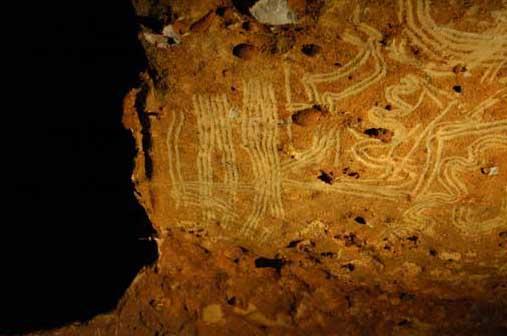Mysterious cave art thought to be done by children 13,000 years ago
Finger flutings in Rouffignac Cave complex. (Photo: Reesvalley, Wikimedia Commons)
Story by PRI’s The World. Listen to audio above for full report.
There are many theories on why Paleolithic humans created cave drawings, but archeologists working in the Rouffignac Cave in south, central France have added another piece to the puzzle. They think children as young as three, four or five did some of the artwork. So, part of the cave complex may have served as a kind of prehistoric nursery where kids were encouraged to develop their creative skills in cave art – 13,000 years ago.
The drawings, known to researchers as finger flutings, are “almost like finger paintings, but without the paint and done in clay,” archaeologist Jessica Cooney told PRI’s The World. Lines and zig zags cover the walls, and some of the drawings depict symbolic symbols and possibly anthropomorphic figures.
“The cave’s been known for a really long time, and these lines and drawings were just kind of mysterious figures,” Cooney explains. Some 10 years ago, however, researchers were “able to get thousands of children and adults today to recreate finger flutings in clay and plaster of Paris.”
They used that information and compared it to the cave drawings. “By measuring the width of your three middle fingers, you can actually get a very individualized number,” Cooney says. “People who had a measurement of 34 mm or less are actually children who are 7 years old or younger,” and some of those people contributed to the cave drawings.
The findings are shedding light on Paleolithic societies. “Back in the day, children might not have necessarily been so separate,” Cooney says. The cave is huge, and it takes 45 minutes to get from one end to the other. “We do find children everywhere throughout the cave,” according to Cooney, “There’s no area that only has adults or only has children.”
“We think that this actually prove proves that children were very involved in the day to day life, in the daily activities,” Cooney explains.
Cooney hopes that the findings will inform other archaeological sites, and may bring about a greater understanding of Paleolithic societies and why people made Paleolithic art more generally. She also advises new parents: “If your kid start to draw on the kitchen wall, maybe you shouldn’t wash it off. Who knows, in 13,000 years, it could be world famous.”
For video of the cave drawings, visit The World website.
———————————————————-
PRI’s “The World” is a one-hour, weekday radio news magazine offering a mix of news, features, interviews, and music from around the globe. “The World” is a co-production of the BBC World Service, PRI and WGBH Boston. More about The World.
